August 4, 2009: Barry Cauchon.
John Elliott has completed his 2nd of 3 parts on the Washington D.C. Arsenal Penitentiary. This segment covers the period from 1865 to 1869 and discusses the trial, the executions, the aftermath and fate of the penitentiary.
Excellent job John.
Enjoy.
Barry
———————————————–
THE WASHINGTON D.C. ARSENAL PENITENTIARY (Part 2 of 3)
A History of the Prison Where the Conspirators of the Lincoln Assassination Were Tried and Hanged
Part 2: The Trial and Execution Period (1865-1869)

One of the hoods worn by the Lincoln Conspirators

Secretary of War Stanton
Following the assassination of President Abraham Lincoln and the failed attempt to cripple the Union government, Secretary of War Edwin Stanton vowed to capture and punish those who carried out the heinous attacks. It was widely believed that such a strike against the North was a calculated, military tactic by Jefferson Davis and the South to re-ignite the war against the Union.
Stanton initiated the aggressive pursuit of those involved in the conspiracy and ordered the arrest of hundreds of suspects and witnesses. The investigation quickly led to the apprehension of several people with direct involvement in the plot. Six of these suspects: Lewis Powell, David Herold, George Atzerodt, Ned Spangler, Mike O’Laughlen and Sam Arnold were captured and subsequently confined to Union Navy ships while the majority of the general detainees were held in the Old Capitol Prison and Carroll Annex. Dr. Mudd and Mary Ann Surratt were held in the Old Capitol Prison but were considered prime suspects.

The Old Capitol Prison

Union Navy Ship U.S.S. Saugus...one of the monitor class ships that imprisoned some of the conspirator suspects.
In order to group the criminal defendants in one place and separate them from the rest of the detainees, Major Thomas Eckert suggested to Secretary Stanton that the old Arsenal Penitentiary be re-activated. Major Eckert was the Telegraph Superintendent of the War Department and a trusted friend of President Lincoln. He was one of the many people who had declined the President’s invitation to attend the play “Our American Cousin” that tragic evening.
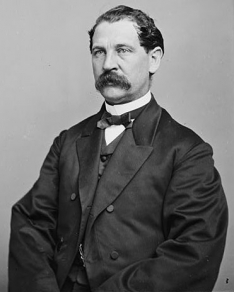
Major Thomas T. Eckert
The Penitentiary had not been in use as a prison for three years. Surrounded by water on three sides, it was considered to be one of the most secure and heavily guarded places in Washington D.C.
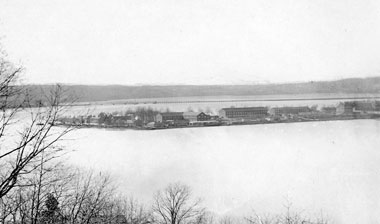
Distant view of the Washington D.C. Arsenal
It had plenty of cells to accommodate the prisoners and even had a large enough room (on the 3rd floor of the former Deputy Warden’s quarters) to host the trial. Security was extremely important because it was thought that the Southern forces may try to break the prisoners free or that northern loyalists may try to exact revenge on the conspirators.
On April 28th, 1865 Secretary Stanton ordered the commanding officer of the Arsenal to prepare the prison building for its new inmates. Prison cells in the female ward (these cells were twice as large as the men’s cells) were cleared and inspected. Shuck mattresses were delivered to the cells and nails were taken out of the walls to ensure that the prisoners would not harm themselves or possibly others.
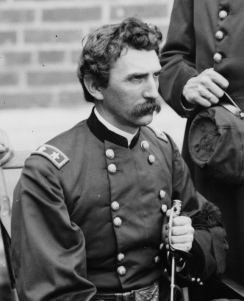
General John F. Hartranft
Andrew Johnson appointed 34 year old General John F. Hartranft to take command of the Arsenal Penitentiary. He would serve as the provost marshal and military governor of the prison and would be responsible for the defense of the Arsenal as well as the supervision of every aspect of the prisoners’ daily lives. He would make sure they were fed and cleaned and that no one would communicate with them unless authorized by written orders of Secretary of War Stanton.
Rules of the Prison
By May 4th, all eight of the suspects would be imprisoned at the Arsenal. Gen. Hartranft was issued a list of rules to guide his governance. Four of the twenty-eight rules of governance were as follows:
1. The keys of the Military Prison will be kept by the Military Governor who will make a personal inspection of each prisoner at least twice every twenty four hours.
The first inspections began at 7 am and the second would usually occur at 8 pm.
2. A medical officer will be assigned to make a medical inspection daily with the Governor twice in twenty four hours. The inspection will be made in the presence of the Governor and at the times he makes his inspections.
The two medical examinations may seem excessive until you examine the following rule –
3. No prisoner will be allowed to escape alive or to defeat the ends of justice by self destruction.

Dr. George L. Porter
Dr. George L. Porter, the appointed army physician of the Arsenal, accompanied Gen. Hartranft and conducted physical examinations of each prisoner. He was permitted only to ask or answer medical questions from the inmates. No other communication was allowed.
Dr. Porter also holds the distinction as being one of the few people who saw John Wilkes Booth buried in the storage room of the Penitentiary on April 27th, 1865.
4. The prisoners are to be supplied with nothing but necessary food and water during their imprisonment unless by special order….and the Military Governor will be responsible for preventing any knives, spoons or other articles from going into the possession of any prisoner, wherewith he may attempt to escape or take his own life or injure his person.
The prisoners’ meals usually consisted of coffee or tea, bread and salted meat. After finishing their meal, the bowl in which their beverage was served was removed. No other items would be brought in to the cell.
The Courtroom Layout
Special modifications were made to the building in order to have the trial on the third floor. The courtroom was located in the northeast corner of the prison. According to various sources, the courtroom measured 40 feet by 27 feet in size. Michael Kauffman details the courtroom layout and modifications in “Fort McNair and the Lincoln Conspirators”:
A door was cut through the wall between the courtroom and the women’s cells, where all of the prisoners were kept. This would allow the accused to reach the courtroom without having to pass through the public areas of the building’s lower floors. The courtroom itself was whitewashed and a raised platform with a wooden railing was constructed for the prisoners to sit on while the court was in session. Flat bars were placed over the windows and gas lighting was introduced into the room.
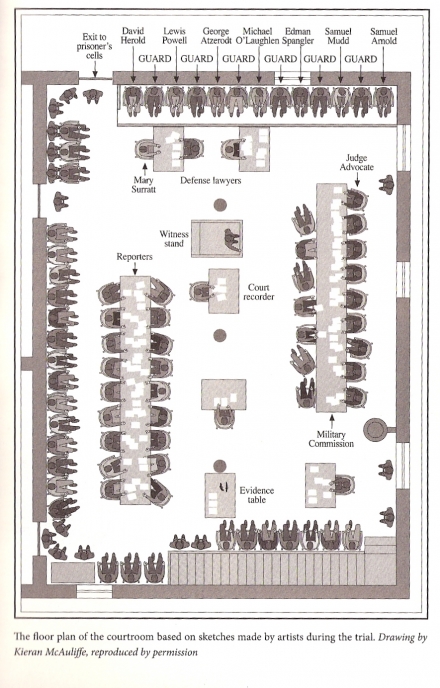
Courtroom Layout in the Arsenal Penitentiary
A staircase ran along the east wall and led to a doorway in the northeast corner of the room. The courtroom had two windows that faced north and two to the east. The prisoners were kept in the same seating arrangements throughout the trial. Samuel Arnold was the closest defendant to a window and would often be seen staring out into the freedom of the Washington D.C. skies. Two doors on the south side of the wall led to adjacent rooms. The rooms were supplied with beds and chairs for witnesses, members of the legal teams and military commission.
The platform that was built for the prisoners stretched along the west wall and led to a doorway that opened to the cell block. Thirteen chairs were placed on the platform to accommodate seven prisoners and the six guards that sat alternately between them.

Courtroom Sketch
Mary Surratt and her counsel had their own table that was situated near the platform. This special arrangement may have been due to the fact that she was having health issues and fell ill during the trial. It was thought that her condition might improve if she was given more room to breathe.
General Hartranft wrote in his journal that “Mrs. Surratt became so ill that it was necessary to remove her from the courtroom”. At one point, she was permitted to sit in one of the adjoining rooms in order to avoid the sweltering heat and uncomfortable conditions of the crowded trial room.
In the north side of the courtroom stood a large table for the members of the commission, and on the south side was an equally large table for spectators and reporters. Between them was the witness stand, where the witnesses faced the commission to give their testimony. Smaller tables were provided for counsel and evidence.

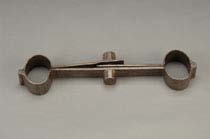
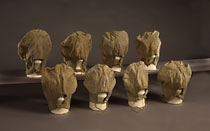
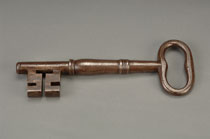
Strict security measures were put in to place during the trial. A different guard would be used to escort the heavily shackled and hooded prisoners to the courtroom each day. In order to preclude the conspirators from talking with each other, they were forced to wear canvas hoods on their way to the courtroom and in their cells — all except for Dr. Mudd and Mary Surratt. They were never forced to wear hoods.
General Hartranft also saw to it that the inmates were never allowed to occupy adjacent cells. In order to prevent messages from being tapped out to each other through the walls, every other cell was left empty. Additionally, the prison guard detail was changed out on a daily basis to make sure that no single guard would guard the same prisoner more than once.
General Hartranft respectfully and dutifully fulfilled his obligations as Military Governor of the Arsenal. This was not an assignment that he took with much enthusiasm. Even his wife tried to talk him out of becoming known as a “hangman”. Difficult as it was, General Hartranft could take pride that he was selected due to his outstanding achievements and excellent record as an obedient soldier. Only the best officer could be counted on to take this role.
During the trial period, Gen. Hartranft showed compassion towards the prisoners’ well-being on separate occasions. In June, he requested of his commanding officer that five of the six inmates who wore the canvas hoods, be allowed to take them off. The only exception was Lewis Powell. The hood didn’t seem to bother him as much as the others.
From Gen. Hartranft’s journal:
“The prisoners are suffering very much from their padded hoods, and I would respectfully request that they be removed from all the prisoners except 195 (Powell). This prisoner does not suffer as much as the others and there may be some necessity for his wearing it, but I do not think there is for any others.”
During that same month of June, Gen. Hartranft requested and was approved to remove the ball and chain attached to the limbs of prisoners Lewis Powell and George Atzerodt. Powell had been observed by a Sentinel on duty, trying to place a weighted ball against his head in attempt to do damage to himself.

Gen. Winfield Scott Hancock
General Hartranft also saw to it that other requests were granted to the prisoners. He made sure that they received chewing tobacco, writing paper and ink, clothing (including underclothing) and various food items. All of these requests were granted at the permission of his commanding officer General Winfield Scott Hancock.
On July 7th, 1865, General Hartranft completed his duties by seeing to it that the Orders of Execution of four of the prisoners were carried out. The four remaining prisoners (Mudd, Arnold, Spangler and O’Laughlen) would later be transferred to the Island of Dry Tortugas to serve their sentences. The bodies of the hanged conspirators were placed in pine boxes and buried in shallow graves next to the gallows. In November of that same year, the body of Henry Wirz (tried by a military commission and executed at the Old Capitol Prison grounds) would join them. They would remain buried there for the next two years.
In September of 1867, John Wilkes Booth and his co-conspirators would be reunited. Secretary of War Stanton ordered that the Arsenal Penitentiary be demolished except for the eastern and western ends of the building. The ends of the building were to be spared and converted to Officer’s quarters. As a result of the new construction work, all of the conspirators’ bodies would be exhumed and moved to another building on the Arsenal grounds known as Warehouse 1. A trench that measured eight by eighteen feet and six feet deep was dug for the bodies. The bodies were examined and then placed in the trench in the following order (east to west): Booth, Surratt, Powell, Herold, Atzerodt and Wirz.
In February of 1869, Andrew Johnson ordered that the bodies be released to their families. This final act closed the chapter on the Arsenal Penitentiary’s role in President Lincoln’s Assassination.
End of Part 2 of 3
——————————————-
Sources:
Surratt Society: Laurie Verge and Joan Chaconas
Michael Kauffman: FortLesley McNair and the Lincoln Conspirators
Michael Kauffman: American Brutus
David K. Sullivan: Behind Prison Walls: The Operation of the District Penitentiary, 1831-1862
Phyllis I. McClellan: Silent Sentinel on the Potomac
Edward Steers Jr., and Harold Holzer: The Lincoln Assassination Conspirators – The Confinement and Execution, As Recorded In The Letterbook of John Frederick Hartranft
—————————————–
Best
Barry